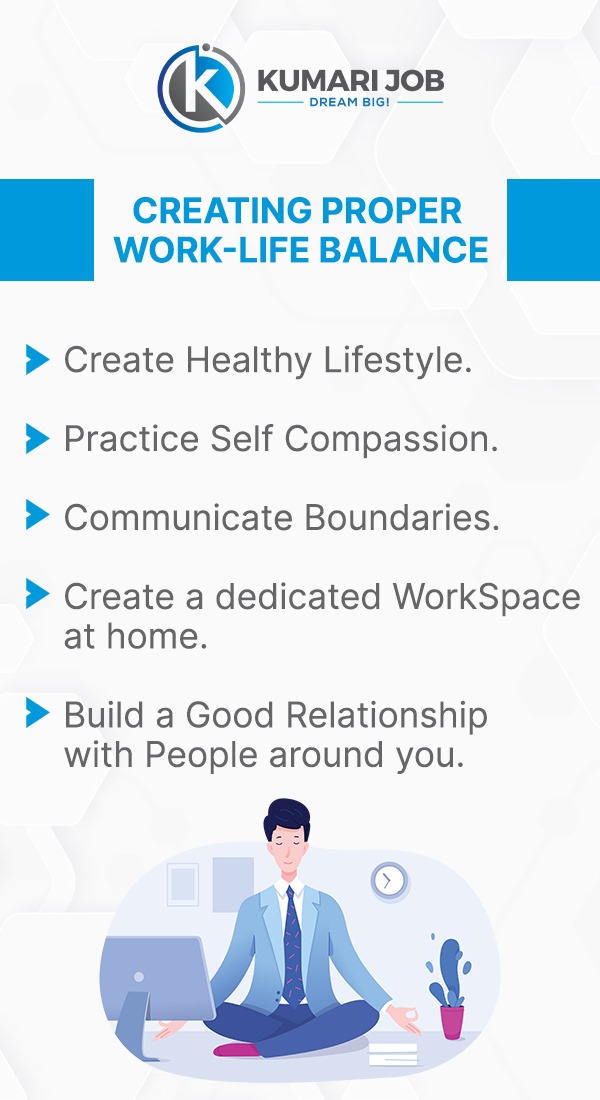Introduction
The concept of 'work-life balance,' known as 'Balance to life,' has gained popularity as a way to balance personal and professional responsibilities. It involves balancing work and personal life, meeting deadlines, self-care, hobbies, and family. This constant struggle for well-being and contentment has made achieving an appropriate 'Balance to life' not just a goal but a requirement, as it helps maintain overall well-being and contentment in our daily lives
Creating a work-life balance is increasingly important in today's workplace due to technological advancements and changing demands. It involves balancing professional obligations with personal life. Setting limits, prioritising work, and managing time are necessary to prevent business obligations from taking precedence. Maintaining a healthy work-life balance is critical for an individual's well-being and productivity, even in constantly changing workplaces. This dynamic equilibrium of creating work-life balance influences long-term professional success, lower stress levels, and increased job happiness, making it a sustainable strategy for long-term success.
An exchange-off is frequently described as a work-life balance. You balance the time you work on projects and the time with friends, family, and hobbies.
It also refers to team members' perceived adaptability in finding balance in life. For example, can you reconcile your personal life's demands with your work? Are you able to react when needed? How much do priorities at work and home conflict with each other?
In this blog
Creating a Healthy Work-Life Balance
Benefits of Work-Life Balance
Fewer Health Issues
Finding a healthy work-life balance is crucial for well-being, reducing health issues, and promoting happiness. It involves setting limits, prioritising self-care, and reducing stress levels to improve and strengthen the immune system.
- Stress Management: A well-balanced work-life schedule can reduce stress levels, potentially reducing the likelihood of health issues like hypertension and cardiovascular problems.
- Enhanced Mental Health: Creating time for leisure activities and personal goals can enhance mental health and reduce anxiety, sadness, and burnout risk.
- Improved Immune Function: A balanced work-life balance enhances an individual's immune system, increases disease resistance, and offers long-term health benefits.
Compared to people who don't work extra, overtime workers have a 60% increased risk of heart-related issues and a lower reported general health.
Regularly putting in extra time is also linked to
- Heightened soreness in the muscles and neck,
- Higher rates of workplace injuries,
- Unhealthy increase in weight,
- A higher probability of smoking,
- Increased rates of alcohol intake,
Enhanced Mental Well-being,
Stress reduction and burnout prevention are two ways a balanced work-life balance promotes improved mental health. Setting aside enough time for leisure and personal pursuits helps people think positively, which improves their general well-being.
Improved Physical Health
Regular exercise and self-care are made possible by a work-life balance, positively affecting physical health. Getting enough sleep and reducing sitting down boosts immunity and gives you more energy.
Increased Productivity and Creativity
Productivity is increased when work and personal life are balanced. Taking a break from work-related responsibilities can help you mentally recharge and develop your creative and problem-solving abilities, enhancing your effectiveness at work.
Strengthened Relationships
Strong relationships are created and maintained via spending quality time with friends and family. Maintaining a healthy work-life balance enables people to foster interpersonal relationships, leading to a more meaningful and contented existence.
Enhanced Job Satisfaction and Retention
Keeping a good work-life balance increases employee satisfaction. Workers who manage their time and lead happy personal lives are likelier to remain dedicated to their work. This may result in higher staff retention rates and lower business recruiting and training expenses.
Improved Punctuality
People who maintain a healthy work-life balance tend to be more reliable and take fewer unneeded vacation days. As a result, there is a decrease in absences, guaranteeing a more steady and reliable staff. Workers with support in a healthy work-life balance also exhibit a strong sense of dedication and commitment to their jobs.
Causes of Poor Work-Life Balance
Overreliance on Technology
The lines separating business and personal life are becoming blurred due to the widespread use of technology, particularly cell phones and constant contact. An inability to completely detach from work results from maintaining a work-life balance, constant notifications, and the expectation to be available at all times, which can lead to a poor work-life balance.
High Job Demands and Expectations
Unrealistic expectations, tight deadlines, and heavy workloads can lead to a poor work-life balance. Setting aside time for personal hobbies might be difficult for workers under constant pressure to fulfil demanding work responsibilities.
Lack of Boundaries and Clear Communication
People may find it challenging to establish boundaries when there is a lack of clarity about expectations for duties and working hours, as well as poor communication within the business. Uncertainty like this can cause an imbalance when workers find it difficult to determine when their workday starts and finishes.
Fear of Job Insecurity
Many industries are competitive. Thus, people may over-commit to work due to job security worries. This concern may make them reluctant to take breaks or set boundaries for their working hours, ultimately negatively affecting their work-life balance.
Improve Work-Life Balance at Work
Learn to say “no.”
Acquiring and applying the soft skill of saying no is crucial for professional success. It involves evaluating daily responsibilities and identifying tasks using the Eisenhower Matrix. Saying no to less important tasks frees up time for more important tasks.
Take breaks
Even a 30-second pause can help
Boost focus,
Lessen tension,
Maintain your sense of involvement,
Increase the pleasure you derive from your work,
You should pay particular attention to this when working from home.
Senior lecturer Robert Pozen of MIT suggests pausing for fifteen minutes every seventy-five to ninety minutes. Your brain will be able to consolidate and retain knowledge as a result.
Practice self-compassion.
Perfectionism can hinder work-life balance and can lead to stress and emotional strain. Acknowledging life's challenges and not always doing things "right" can help shift perspectives towards growth and learning. This approach can help achieve equilibrium and serve as an inspiration for others seeking to overcome their perfectionism. Acknowledging that difficulties arise in life can lead to a more compassionate and balanced approach to work and life.
Set Clear Boundaries
A healthy work-life balance requires setting defined work hours. Setting and sticking to set work hours helps you establish a habit that keeps work from interfering with your leisure time. Furthermore, maintaining the boundaries between your personal and professional lives is reinforced when you resist the temptation to answer calls or check work-related emails after hours.
Prioritise Tasks
Prioritizing and focusing on tasks are essential to effective task management. Larger activities are less daunting and more productive when broken down into smaller, achievable phases. Setting task priorities enables you to concentrate on what matters, allocating your time and attention to the most important—areas of your professional and personal life.
Learn to Say No
Requiring the ability to say no when necessary is essential to maintaining a work-life balance. To avoid burnout, you must be realistic about how much work you can do and refrain from overcommitting. Knowing your limits and turning down tasks that can throw you off balance are good practices that enhance well-being.
Creating Work-Life Balance at Home
Create a Dedicated Workspace
Setting up a certain space for work aids in creating a distinct division between your personal and work areas, promoting work-home life balance. Having a designated workstation helps you concentrate better during work hours and mentally shift from work to personal life when you leave the area. It is better to have this physical distance between job and life.
Communicate boundaries so you can truly unplug
Establish clear boundaries by setting and communicating work hours to colleagues and customers to avoid work-life imbalance. Include when you'll work and when you won't be available for responses. An easy way to do this is by setting up an autoresponder to alert those who contact you via email that you're offline. This message informs them when you'll respond, reducing the pressure to check work emails constantly. Another way to achieve this is by setting up an autoresponder to inform those who email you when you're unavailable, allowing them to learn when you'll reply.
Invest in relationships
A weak social network increases the risk of dying young by 50%, similar to smoking fifteen cigarettes daily. Strong bonds and social support can prolong life and improve health. Prioritising fostering important relationships is crucial, and following the instructions to unplug can help focus on those you spend time with.
Prioritize quality time
To maintain balance and fulfilment, prioritize what matters to you and use your free time well. Do an Ikigai exercise to determine priorities, examine activities and relationships, and allocate time accordingly—Prioritise self-connections and set aside time for introspection and renewal.
Frequently Asked Questions
The harmony between one's personal and professional lives is known as work-life balance, essential for lowering stress levels and improving general well-being.
Set clear boundaries, prioritise tasks, delegate, and schedule intentional breaks to maintain balance.
Include exercising, reading, meditation, hobbies, and quality time with loved ones in your schedule.
Emphasize in your open and passionate conversations how crucial it is to preserve a healthy work-life balance for your well-being and productivity.
Involve them in the planning process and communicate your objectives to foster mutual understanding and support as you work toward living a balanced life.
Implement clear work hours, avoid work-related emails or calls after hours, and use autoresponders for offline communication to reduce constant pressure.
Poor work-life balance is linked to increased stress, cardiovascular risks, muscle soreness, workplace injuries, unhealthy weight gain, smoking, and higher alcohol intake.
Conclusion
A happy and balanced existence depends on having a work-life balance, which affects relationships, productivity, and mental and physical health. It's a group obligation within corporations as much as an individual one. Overuse of technology and demanding work schedules contribute to poor balance. To promote a culture that encourages well-being, employers are essential. The path to equilibrium is complex and dynamic, involving thoughtful technology adoption, meaningful relationships, and optimal work arrangements.
For more Career Tips : https://www.kumarijob.com/careertip




